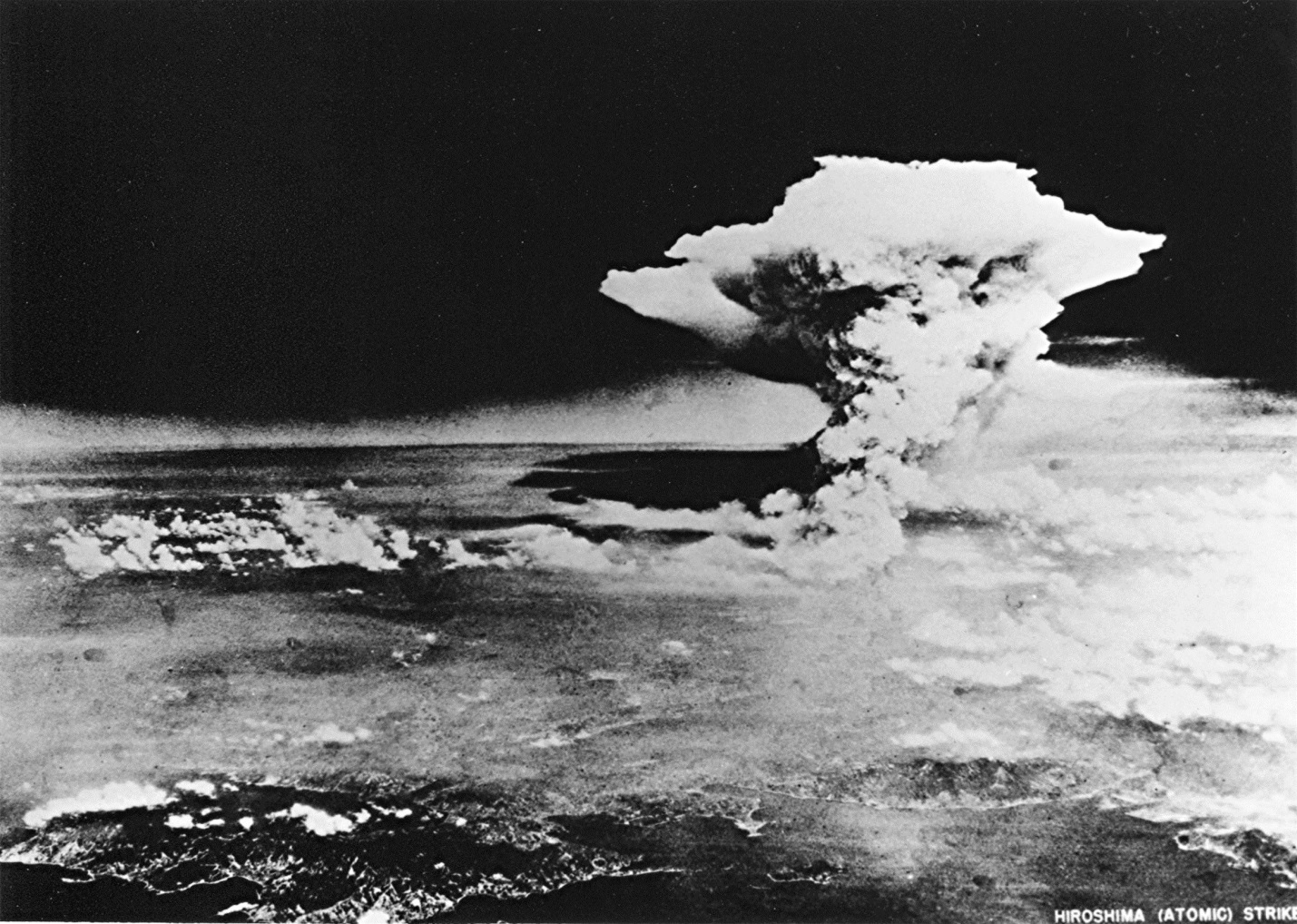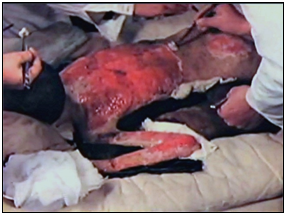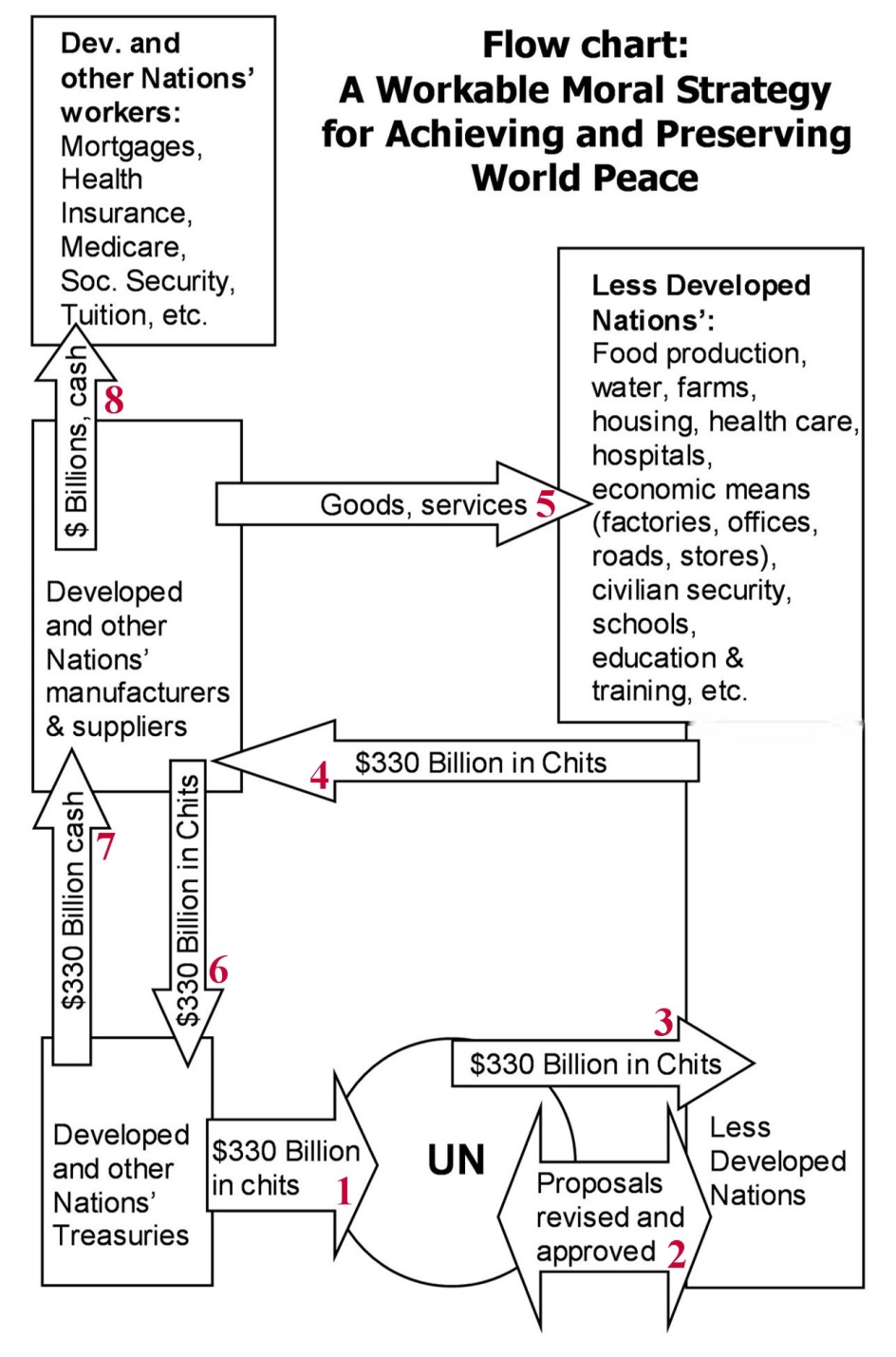Revealed: A Workable Moral World-Peace Plan

By Raymond G. Wilson*
Emeritus Associate Professor of Physics
Illinois Wesleyan University
rwilson@iwu.edu
Abstract: It has become clear that nuclear weapons are only a symptom of an all-pervasive malignancy of the spirit of the world and of humankind. Some Japanese have an expression for this period of human history in which we find ourselves; they call it “the era of nuclear madness.” We propose here a workable moral strategy that would put “everyone” back to work; bring peace and stability; end war-sacrificed lives; and ensure corporate profits, growth, and cooperation; and would allow people to return to peaceful opportunity-laden homelands.
(Some readers may be upset about this information, perhaps even angry,
which I don’t understand because “the plan” provides for exactly
what the abstract says, and more. So if you find yourself perturbed,
try to think outside the box as I did; this plan will work.)
Why world peace is necessary
The sun was rising, only a few clouds; prospects for a good day ahead; but August in Japan — this was likely to be a hot day. With quiet thoughts to themselves and of family members living in Hawaii and on the American west coast, some, very hungry, were optimistically expecting the war to end soon.
That Day: August 6, 1945, 8:15 AM: In the center of Hiroshima, just above Shima Hospital, it seemed like the sun had descended to the earth, followed by the sky blasting down in a Richter-10 cosmic quake from the gods, “rattling the earth’s axis,” scorching, searing, roasting, irradiating, blasting, and crushing everything and everyone below. The sun touched Hiroshima, a blazing inferno with no escape; nuclear radiation made people’s bones radioactive, blast winds in excess of 200 mph. The blast overpressure blew out ear drums and forced eyeballs out of their sockets (exophthalmos), hurled and slammed people into walls. Scorched blistered skin sloughed and peeled off their bodies and dragged on the ground as they tried to escape. The retinas of eyes looking up were burned. Stone and concrete buildings were fire-gutted to their cores, the blast-shattered glass window fragments sharply tearing into the bodies of those within, and without.
This happened to Hiroshima citizens within seconds on August 6. Birds and butterflies never had a chance. On August 7 the Mayor and whoever else he could find, had to deal with 70,000 dead under their crushed burned homes and heaped and strewn all over the streets, bridges, and river banks of Hiroshima. Over the next two weeks more people would die, day and night, averaging 160 per hour. Radioactivity was all over the center of the city. Thirteen square kilometers of homes, stores and shops destroyed. One small and primitive nuclear bomb, the equivalent explosive power of 16,000 tons of TNT detonated over the city of 350,000, emitting a huge flood of nuclear radiation. By Dec 31, 1945 the death toll was about 140,000 and the counting could not stop then. Hiroshima City was wiped off the earth. More than 140,000 people, mostly civilians, disposed of as ashes and smoke.
Hiroshima City, population 350,000: below the cloud were some 200,000 trapped by the fire, destruction, and fatal injuries. 70,000 dead by August 7, about 140,000 dead by December 31.

August 9, 21,000 tons destroyed Nagasaki and its people, killing another 70,000 by year’s end. By hindsight and knowledge later gained from surviving Japanese government officials neither bomb was necessary to bring about the end of the war.

Sumiteru Taniguchi, age 16 in 1945, was the only one of 28 postmen in his group to survive. He was a mile away from the Nagasaki hypocenter. A mile away from this small nuclear bomb was not far enough. There is no escape.
It has become clear that nuclear weapons are only a symptom of an all-pervasive malignancy of the spirit of the world and of humankind. Some Japanese have an expression for this period of human history in which we find ourselves; they call it “the era of nuclear madness.”
Since 1945 there have been no world conflicts which could have justified the use of nuclear weapons, and none this year. Will there be any upcoming conflicts with our major trading partner, China? Will there be a war because Russia (usually a US trading partner) illegally annexed Crimea? Are there any American politicians, any “decision makers” or “deciders” that would use nuclear weapons to “correct” international conflicts? Is there anyone in the world qualified to make such a decision? Would any such decision be justifiable?
There are people who consider nuclear bombs to be useable weapons of war; after all, in 1945 the Allies actually used two, which many believe ended that war. “If we have them, why can’t we use them?” During the 1946 Bikini nuclear tests in the South Pacific, U.S. congressmen, invited to witness the tests, were located so far away (for their safety) that many came away naively expressive. “Like a giant firecracker,” said one. Another, "In the next war I hope we don't have to throw atomic baseballs...“
Later, a team of American congressional investigators concluded, “The greatest irony of our atmospheric nuclear testing program is that the only victims of United States nuclear arms since World War II have been our own people.”
A prediction of “Constant Conflict,” “There will be no peace. At any given moment for the rest of our lifetimes, there will be multiple conflicts in mutating forms around the globe. Violent conflict will dominate the headlines, but cultural and economic struggles will be steadier and ultimately more decisive. The de facto role of the US armed forces will be to keep the world safe for our economy and open to our cultural assault. To those ends, we will do a fair amount of killing.” (Major (P) Ralph Peters of the Office of the Deputy Chief of Staff for Intelligence, 1997, where he was responsible for future warfare (retired as Lieutenant Colonel in 1998).
Dwight D. Eisenhower recognized war for what it was. ― “I hate war as only a soldier who has lived it can, only as one who has seen its brutality, its futility, its stupidity.”
Carroll Quigley (Professor at Princeton, Harvard, & School of Foreign Service at Georgetown) ― “The powers of financial capitalism had a far-reaching [plan], nothing less than to create a world system of financial control in private hands able to dominate the political system of each country and the economy of the world as a whole.” From Tragedy and Hope: A History of the World in Our Time, 1966, (1359 pages). Who authorized that “financial control”?
Albert Einstein ― “The result of these developments is an oligarchy of private capital the enormous power of which cannot be effectively checked even by a democratically organized political society. …since the members of legislative bodies are selected by political parties, largely financed or otherwise influenced by private capitalists who, for all practical purposes, separate the electorate from the legislature. Einstein again, “…unless by common struggle we are capable of new ways of thinking, mankind is doomed.” “At present we are bound by political thinking, much of which seems dictated by private financial interests, not human or necessarily moral interests.”
Let us attempt some “new ways of thinking,” based upon human and moral interests.
Consider the following: It must be true that in an ideal peaceful world, a world without the conventional weapons of war, without tanks, missiles, bombers, warships, drones, there would be no need for nuclear weapons, so-called weapons of mass destruction, weapons that treat people like matter.
A world without conventional weapons of war, and thus no need for nuclear weapons, could that be achieved?
The world initiatives for action need to be stripped away from the military industrial establishment and also from the war mongers with their insidious subversions, their mythological belief in their superiority and destiny to rule the world. World initiatives need to be directed toward peace, not war, for all those nations which are ready for peace, ready for the promised advances of the 21st century. At present U.S. foreign policy is subverted by events abroad, events over which we have little control.
J. Robert Oppenheimer, “father” of the United States’ atomic bombs, told us in 1946, “… wars might be avoided by: universal disarmament; limited national sovereignties; provision for all people of the world: of a rising standard of living, better education, more contact with and better understanding of others; and equal access to the technical and raw materials which are needed for improving life…”
What shall be proposed: would put “everyone” back to work; bring peace and stability; end war-sacrificed lives; and ensure corporate profits, growth, and cooperation; and would allow people to return to peaceful opportunity-laden homelands.
This workable moral strategy seems the only approach, for decades or centuries to come, by which people of the Less Developed world, in peace, without war, can become their own masters, can create the sensible path to their own destinies, as so many other nations have done, and live to enjoy some of it. This workable moral strategy exports no United States’ or other nation’s money; it fosters the expressed desires of all people and nations seeking peace, justice, opportunity, and a better life. This strategy has been referred to by one as “brilliant.” Well, certainly; the strategy incorporates ideas advocated by Robert Oppenheimer, Philip Morrison & Kostas Tsipis, Albert Einstein, and James C. Warf, some very bright fellows. What will be described and recommended is a workable moral strategy that Barack Obama might well refer to as the “incentivization” of world peace. (You may wish to compare it with the world peace plan of the United States, or that of Russia or China or the United Nations.)
A Workable Moral World-Peace Plan
The United States announces a strategy, that starting one year from now it will revise the manner by which it provides aid to all other nations and particularly to those of the Less Developed world, provides aid using American taxpayers’ wealth. It will no longer be direct aid. All other Developed nations are encouraged to similarly participate so that they can also obtain the benefits which will accrue to them just as benefits will accrue to the United States.
Henceforth, rather than direct aid, the United States will provide the United Nations with $165 billion per year in “credit chits” (promissory notes) for use by Less Developed nations. Other Developed nations are invited to contribute in total an additional $165 billion in “credit chits” to the UN; more if they wish. No actual money leaves any nation. The credit chits originating in the U.S. will only be redeemable for cash at the United States Treasury by American businesses and industries. With cooperation from other nations it means $330 billion or more per year of development to the Less Developed world, very roughly 10 times what is now provided by the U.S. alone, a great deal of which we know under the current system is wasted, corrupted, or spent on tools of war. (e.g., 43 Toyota trucks into Syria)
Affordable? On April 10, 2009 the small nation of Japan, not at war with anyone, announced a $150 billion government stimulus package. In 2009 Japan thought it could afford to do this. I can hear a conservative United States Congress shouting that we cannot afford to do something like that. But financial resources are always found for wars. We can be smart enough to find them for a peace which eliminates wars and the costs of wars. July 27, 2016, Japanese Prime Minister Abe announced another economic stimulus package, this time, $265 billion. In August, 2016, P.M. Abe pledged that Japan will invest $30 billion in Africa by 2018.
We can show that this workable strategy will lead to more than 500,000 U.S. peacetime manufacturing jobs in the first year, and more than 500,000 other peacetime jobs throughout the world.
The United Nations makes the “credit chits” available to peaceful democratic nations of the Less Developed world. To help them along the way chits will also be very cautiously offered to those nations which are verifiably peacefully evolving toward equitable nondiscriminatory constitutional democracy. The chits are made available to Less Developed nations on the basis of solicited application of: development proposals from them, verifiable need, and guarantees against misuse or corruption.
These chits to be offered by the United Nations may be utilized only for social and economic development, six specific self-sufficiency goals:
- modern appropriate agriculture, food, and fresh pure water production;
- good housing and its basic amenities, including electricity, plumbing, sewage;
- health care, with hospitals and well-trained doctors;
- national wealth creation and infrastructure from their own natural and human resources;
- civilian security, and;
- education and training at all levels to support items 1-5.
The solicited development proposals submitted to the United Nations by Less Developed nations will be carefully evaluated, in terms of the proposed societal, cultural, economic, and environmental impact, and in terms of protection against abuse and corruption. Unacceptable proposals shall be returned for revision until they are in line with this UN sanctioned strategy. The UN will aid revisions.
The United Nations, administering this program, will not grant chits to nations where war exists or is likely or where violations of rights: gender, religious, human, or ethnic, are active or not being remediated. Repressive and military governments and martial law governments will not qualify for participation in this program, nor will any nation, chit donor or receiver, regardless of its power and influence, which is not fully and actively transparently participating and cooperating in the worldwide elimination of: armaments of war, nuclear weapons, terrorism, and the illicit drug trade.
 In democracies seeking peace and advancement what will the people choose?
In democracies seeking peace and advancement what will the people choose?
All the above is the essential specification to this workable moral strategy for achieving and preserving world peace. There are three additional “recommendations,” in Chapter 5 of the author’s book from which this document has been extracted and abridged. See † at end.
There will be great advantages to all nations who make chit deposits into this program, and considerable disadvantages to those who can, but do not. The more chits deposited, the greater economic value accrues to the depositor nation. It should be obvious.
Each year this workable and moral program will see returned to the nonmilitary economies of the Developed nations, in total, some US$330 billion or more, to be used solely for peacetime goods and services! Hence, this proposed program should greatly reduce unemployment in any nation participating, supplier or receiver. This program will put workers, the original creators of wealth, back on the job. I would estimate that the first year could create in the U.S. alone some 500,000 or more jobs, and at least that many outside the U.S. Where do we get such an estimate of the number of jobs to be created or restored? David Swanson in Roots Action, Sept. 9, 2011; Political Economy Research Institute at the University of Massachusetts (Amherst). (http://rootsaction.org/news-a-views/232-i-just-found-29-million-jobs)
Consider, compare, what the 3,500,000,000 people of the Less Developed world do not have, and who is capable of supplying it! There are abundant opportunities for all! This is “The Incentivization of World Peace.”
An exchange can be made:
—With self-sufficiency and self-defined but true democracy growing in the Less Developed world and the virtual elimination there of poverty, illiteracy, malnutrition, disease, neocolonialism, rights deprivation, indebtedness, exploitation, and slavery;
—The entire world could have full economic recovery, elimination of the possibility for international nuclear catastrophe, and the practical elimination of war.
—In a world at peace the refugee problem is solved. The killing stops and solutions to world-wide problems can be found. The basic tool is cooperation and proper incentives, not sanctions, boycotts, and deadly threats; justified benefits, not penalties; advantages for all. As promised, no money would leave any nation or pass through the UN, and the credit chits never pass through the World Bank, or any bank, or the International Monetary Fund.
Justification: A Moral World View— Does the Developed World and its people have any responsibility for the conditions of poverty, starvation, slavery, disease, displaced refugees, rights deprivation, war and killing, and illiteracy, etc., as they now exist in the former colonial and Less Developed world, in Africa, in Asia and the Middle East, in Latin America?
Over past centuries has the Developed World exploited the people of the UnDeveloped World? Have you and your nation taken selfish advantage of people of the Less Developed world?
If so, does the Developed World have any unfulfilled moral obligations to the former colonial and Less Developed World?
Adoption of this Incentivization of World Peace would go down in history as the turning point which saved the earth and its people from the return to the darkest ages. For all nation’s Congresses and Parliaments it would symbolize the wisdom of finally coming to their senses.
When nations are at peace, they advance. It should be obvious.
*Raymond G. Wilson is an emeritus Associate Professor of Physics, Illinois Wesleyan University, and has taught about nuclear war for over 53 years, and has spent 17 summers of study and exploration in Hiroshima and Nagasaki. rwilson@iwu.edu
**The image on page 1 above is adapted from the Barefoot Gen books by Keiji Nakazawa, with his permission. Gen (author Keiji Nakazawa) experienced the August 6, 1945 Hiroshima A-bomb.
†Adapted from his book, where the plan is developed more completely in Chapter 5,
Nuclear War: Hiroshima, Nagasaki, and A Workable Moral Strategy for Achieving and Preserving World Peace, 2014. There is a “Caution” on the cover. The book is not for profit.
The PDF book download is available at no cost here, http://sun.iwu.edu/~rwilson/PNDclass.html.